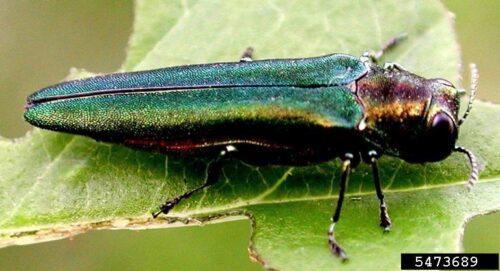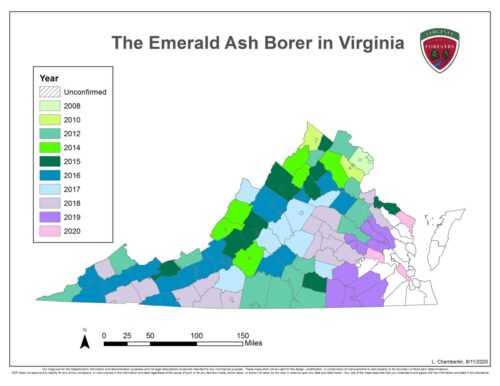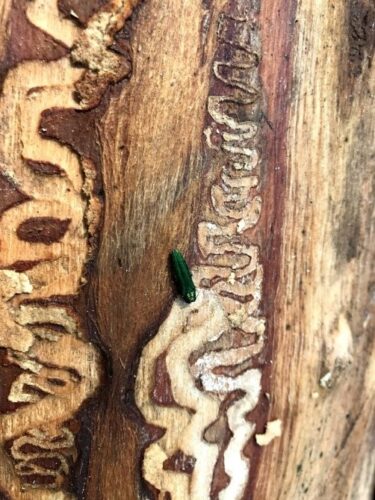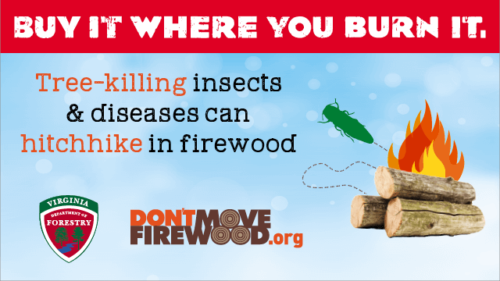Deadly Jewels of Virginia Forests
June 9, 2022 8:49 am

By Amanda Conrad, VDOF Forest Health Technician
The vibrant, metallic green of an emerald ash borer (EAB) makes it look like royalty of the forest. But this beautiful, invasive insect is also deadly. Just one beetle can lay 40-70 eggs on the bark of its preferred host: ash trees. The growing larvae disrupt the flow of water throughout the tree, which will ultimately kill the tree. A healthy ash tree can be killed in just three years from the first symptoms of decline. This insect has devastated the population of ash trees in North America and will continue to survive and multiply as long as there are still host trees available. Due to the high price of control and removal, the EAB is one of the costliest invasive forest insects in U.S. history.

Counties in which EAB have been found as of August 2020.
The EAB has been located and confirmed in almost every county in Virginia. Only counties in the easternmost part of the state have yet to confirm the suspected presence of EAB. Because it is an invasive insect, native trees do not have natural resistance that keep the insect at bay. The insects move naturally to search for new host trees, but the biggest factor in the spread of EAB is the movement of wood by humans, for purposes such as firewood.

The indicative “s-shaped” galleries of EAB
EAB emerge as adults from mid-May to their peak in June. Landowners should be aware that any living ash trees on their property can be a host to EAB. Symptoms of this deadly insect include a thinning tree canopy, epicormic branching (sprouts from the main trunk), serpentine galleries under bark, and D-shaped exit holes on the bark. Another indicator of EAB presence is increased woodpecker activity in the winter, when ash trees can be full of EAB larvae.

There are, however, several options to help manage an infestation and keep trees alive and healthy. An annual soil drench or bark spray is a less costly, but also less effective, method. The best treatment for EAB is a direct trunk injection of the insecticide emamectin benzoate to trees with a live crown of at least 70%. These injections have been shown to keep ash trees alive and healthy for up to three years. This method is fairly costly, thanks to the price of the chemical and the need for specialized equipment.
The Virginia Department of Forestry recognizes that treatment can be a financial burden for landowners and organizations. To help offset the price of treatment, VDOF’s Emerald Ash Borer Cost-Share program can financially assist those who are eligible. This year’s program is open to landowners in the eastern part of the state and to organizations statewide.
Infected ash trees that may not be worth treating can still be utilized as firewood in the same county they are downed, or upcycled into quality wood products. Please remember when you go on a trip to buy firewood at your destination. EAB and other invasive forest pests are often transported in infested firewood, and you may inadvertently spread these pests to more trees and forests.

The emerald ash borer is a devastating invasive pest that can cause widespread damage to single ash trees and acres of forest alike. Through sound management practices, treatment of trees, and monitoring for signs of EAB, this jeweled insect can be a threat of the past.
Cover image: An adult emerald ash borer. Credit Leah Bauer, USDA Forest Service Northern Research Station, Bugwood.org
Tags: Ash, Emerald Ash Borer, Firewood, Insects, Invasive Species
Category: Forest Health
